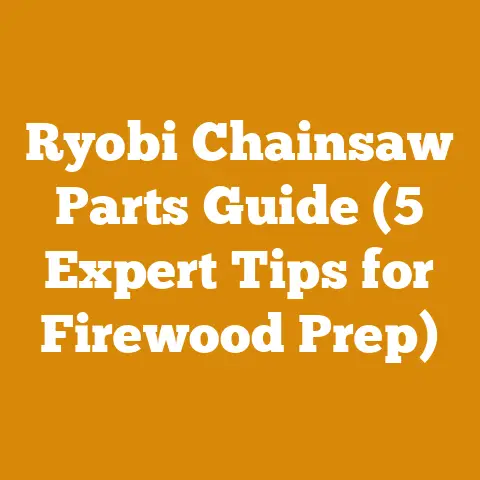Brush Bandit Wood Chipper: Choosing the Best Model (5 Pro Tips)
Okay, here’s the technical documentation on Brush Bandit wood chippers, aimed at helping users choose the best model.
Brush Bandit Wood Chipper: Choosing the Best Model (5 Pro Tips)
Renovating my old farmhouse was a labor of love, but it also meant dealing with mountains of debris. One particularly nasty job involved clearing out a decades-old overgrown orchard. Branches were everywhere – thick apple limbs, thorny bushes, and the occasional fallen tree. Burning wasn’t an option due to local ordinances, and hauling it all away would have cost a small fortune. That’s when I realized I needed a serious wood chipper. I remember thinking, “There has to be a better way than this never-ending pile of branches!”
It was a game-changer. But navigating the world of wood chippers, especially the Brush Bandit lineup, can be overwhelming. There are so many models, each with its own set of specs and features. It’s easy to get lost in the jargon. That’s why I’ve put together this guide, drawing from my own experiences and a fair bit of research, to help you choose the best Brush Bandit wood chipper for your needs. Think of it as your friendly neighborhood expert guiding you through the woods (pun intended!).
Understanding Your Chipping Needs: A Tailored Approach
Before diving into specific models, it’s crucial to understand exactly what you’ll be chipping. This isn’t a one-size-fits-all situation. Are you a homeowner dealing with occasional yard waste, or a professional tree service tackling large-scale land clearing projects? The answer will significantly influence your choice.
1. Define Your Typical Material:
- Type of Wood: Are you mostly chipping softwoods like pine and fir, or hardwoods like oak and maple? Hardwoods require more power and a more robust chipper. This is crucial because the density of the wood directly impacts the chipper’s performance and lifespan. For example, oak has a density of approximately 750 kg/m³, while pine is around 400 kg/m³. Choosing a chipper that can handle the density of wood you’re working with is essential for efficiency and longevity.
- Branch Diameter: What’s the maximum diameter of branches you’ll be chipping? This is perhaps the most important factor. Don’t underestimate! Always allow for a margin of error. A 6-inch capacity chipper should comfortably handle branches up to 5 inches in diameter. Pushing the limit consistently will shorten the lifespan of the machine.
- Material Condition: Are you chipping fresh, green wood or dry, seasoned wood? Green wood is heavier and requires more power to chip. Seasoned wood, on the other hand, can be brittle and produce more dust. The moisture content of wood significantly affects chipping performance. Green wood typically has a moisture content of 30% or higher, while seasoned wood should be below 20%. High moisture content can clog the chipper and reduce its efficiency.
- Volume of Material: How much material will you be chipping on a regular basis? A homeowner chipping a few branches after pruning won’t need the same machine as a professional clearing acres of land.
2. Assess Your Work Environment:
- Terrain: Will you be chipping on flat, even ground, or rough, uneven terrain? A towable chipper with good ground clearance is essential for rough terrain.
- Accessibility: Can you easily maneuver a large chipper into your work area? Consider the size and weight of the chipper.
- Noise Restrictions: Are there noise restrictions in your area? Some chippers are quieter than others.
- Location: Is it a residential or commercial area? Residential areas often have stricter noise regulations.
3. Consider Your Budget:
- Initial Cost: Wood chippers range in price from a few thousand dollars to tens of thousands. Set a realistic budget before you start shopping.
- Operating Costs: Don’t forget about operating costs, such as fuel, maintenance, and blade sharpening.
- Long-Term Investment: Consider the long-term value of the chipper. A higher-quality chipper will likely last longer and require less maintenance.
Personal Story: I once made the mistake of trying to chip some extremely dense apple wood with a chipper that was just barely rated for the diameter. It struggled, strained, and ultimately, I ended up with a bent blade. Lesson learned: always overestimate!
Pro Tip #1: Size Matters – Matching Capacity to Your Needs
The “capacity” of a wood chipper refers to the maximum diameter of material it can handle. Brush Bandit chippers range from smaller homeowner models capable of chipping 6-inch diameter branches to massive industrial machines that can devour 21-inch logs. Choosing the right capacity is crucial for efficiency and safety.
Understanding Capacity Ratings:
- Advertised vs. Real-World Capacity: Be aware that advertised capacity is often optimistic. It’s always best to choose a chipper with a capacity slightly larger than the largest branches you anticipate chipping.
- Feed Rate: Capacity also affects the feed rate – how quickly the chipper can process material. A larger capacity chipper will generally have a faster feed rate.
- Engine Power: The engine power must be adequate for the chipper’s capacity. A chipper with a large capacity but a weak engine will struggle to process larger branches.
Brush Bandit Model Examples & Specifications:
To illustrate the importance of capacity, let’s look at a few Brush Bandit models:
- Brush Bandit 65XP: This is a popular entry-level chipper, typically with a 6-inch capacity. It’s ideal for homeowners and small-scale tree service operations.
- Engine: Typically powered by a gasoline engine ranging from 25 to 37 horsepower.
- Weight: Around 2,500 lbs.
- Ideal For: Small branches, shrubbery, and light-duty chipping.
- Technical Limitation: Not suitable for hardwoods or large volumes of material.
- Brush Bandit 90XP: A step up from the 65XP, the 90XP usually has a 9-inch capacity. It’s a good choice for professional tree services dealing with larger branches.
- Engine: Gasoline or diesel options ranging from 49 to 89 horsepower.
- Weight: Around 4,500 lbs.
- Ideal For: Medium-sized branches, hardwoods, and moderate volumes of material.
- Technical Limitation: May struggle with extremely dense hardwoods or logs with significant knots.
- Brush Bandit 200XP: This is a heavy-duty chipper with a 12-inch capacity. It’s designed for professional tree services and land clearing operations.
- Engine: Diesel engines ranging from 115 to 174 horsepower.
- Weight: Around 8,000 lbs.
- Ideal For: Large branches, logs, hardwoods, and high volumes of material.
- Technical Limitation: Requires a powerful tow vehicle and experienced operator.
- Brush Bandit 255XP: This is a very robust option, often used in commercial logging.
- Engine: Diesel engines ranging from 190 to 250 horsepower.
- Weight: Around 10,000 lbs.
- Ideal For: large-scale operations, including whole tree chipping.
- Technical Limitation: Requires a commercial driver’s license and specialized maintenance knowledge.
Data Point: Studies have shown that using a chipper at or near its maximum capacity can reduce its lifespan by as much as 30%.
Best Practices for Capacity Selection:
- Measure Accurately: Use a diameter tape to accurately measure the largest branches you’ll be chipping.
- Overestimate: Always err on the side of caution and choose a chipper with a slightly larger capacity than you think you need.
- Consider Wood Type: Hardwoods require more power and a larger capacity chipper.
- Think Long-Term: Consider your future needs. Will you be chipping larger branches in the future?
Technical Requirements:
- Blade Sharpness: Regularly sharpen the blades to maintain optimal chipping performance. Dull blades will reduce the chipper’s capacity and increase fuel consumption. The recommended blade sharpening frequency is every 4 to 8 hours of use, depending on the type of wood being chipped.
- Engine Maintenance: Follow the manufacturer’s recommended maintenance schedule for the engine. This includes changing the oil, air filter, and spark plugs.
- Hydraulic System: Regularly check the hydraulic fluid level and condition. Replace the fluid as needed.
Pro Tip #2: Power to the People (or the Chipper) – Engine Selection
The engine is the heart of any wood chipper. It provides the power to turn the cutting disc or drum and feed the material through the machine. Choosing the right engine is critical for performance, efficiency, and reliability.
Engine Types:
- Gasoline Engines: Gasoline engines are typically used in smaller chippers. They are relatively inexpensive and easy to maintain. However, they are less fuel-efficient and have a shorter lifespan than diesel engines.
- Diesel Engines: Diesel engines are more powerful, fuel-efficient, and durable than gasoline engines. They are typically used in larger chippers. However, they are more expensive and require more specialized maintenance.
Key Engine Specifications:
- Horsepower (HP): Horsepower is a measure of the engine’s power output. A higher horsepower engine will be able to chip larger branches and process material faster.
- Torque: Torque is a measure of the engine’s twisting force. High torque is important for chipping dense hardwoods.
- Fuel Consumption: Fuel consumption is a measure of how much fuel the engine uses. A more fuel-efficient engine will save you money on operating costs.
- Emissions: Emissions are a measure of the engine’s environmental impact. Choose an engine that meets the latest emissions standards.
Brush Bandit Engine Options:
Brush Bandit offers a variety of engine options for its chippers, ranging from small gasoline engines to large diesel engines. Here are a few examples:
- Kohler Gasoline Engines: Kohler gasoline engines are commonly used in smaller Brush Bandit chippers. They are known for their reliability and ease of maintenance.
- Kubota Diesel Engines: Kubota diesel engines are a popular choice for medium-sized Brush Bandit chippers. They are fuel-efficient and durable.
- Caterpillar Diesel Engines: Caterpillar diesel engines are used in larger Brush Bandit chippers. They are known for their power and reliability.
Data Point: Diesel engines typically consume 30-50% less fuel than gasoline engines for the same amount of work.
Choosing the Right Engine:
- Match Engine to Capacity: Choose an engine that is powerful enough to handle the chipper’s capacity.
- Consider Fuel Efficiency: If you’ll be using the chipper frequently, choose a fuel-efficient engine.
- Think About Maintenance: Consider the maintenance requirements of the engine. Diesel engines require more specialized maintenance than gasoline engines.
- Factor in Emissions: Choose an engine that meets the latest emissions standards.
Technical Requirements:
- Oil Changes: Change the engine oil and filter according to the manufacturer’s recommendations. This is typically every 100 to 250 hours of operation.
- Air Filter: Clean or replace the air filter regularly. A dirty air filter can reduce engine performance and fuel efficiency.
- Fuel Filter: Replace the fuel filter regularly. A clogged fuel filter can starve the engine of fuel.
- Spark Plugs: Replace the spark plugs (for gasoline engines) according to the manufacturer’s recommendations.
Personal Story: I once neglected to change the air filter on my chipper’s gasoline engine. It ran rough, lost power, and eventually stalled out completely. It was a costly mistake that could have been easily avoided with regular maintenance.
Pro Tip #3: Cutting Edge Technology – Disc vs. Drum Chippers
Wood chippers primarily use two different cutting mechanisms: discs and drums. Each has its own advantages and disadvantages. Understanding the differences is crucial for choosing the right chipper for your needs.
Disc Chippers:
- How They Work: Disc chippers use a large, rotating steel disc with knives mounted on its surface. As the disc spins, the knives slice the wood into chips.
- Advantages:
- Faster Feed Rate: Disc chippers generally have a faster feed rate than drum chippers.
- Cleaner Chips: Disc chippers produce more uniform and cleaner chips, which are ideal for landscaping and mulch.
- Lower Maintenance: Disc chippers tend to have fewer moving parts and require less maintenance than drum chippers.
- Disadvantages:
- More Expensive: Disc chippers are typically more expensive than drum chippers.
- Less Forgiving: Disc chippers are less forgiving of oversized or irregularly shaped material.
- Can Be More Dangerous: If not properly maintained, the knives can become projectiles.
Drum Chippers:
- How They Work: Drum chippers use a rotating steel drum with knives mounted on its surface. As the drum spins, the knives chop the wood into chips.
- Advantages:
- Less Expensive: Drum chippers are typically less expensive than disc chippers.
- More Forgiving: Drum chippers are more forgiving of oversized or irregularly shaped material.
- Better at Handling Debris: Drum chippers can handle debris like leaves and small branches more easily than disc chippers.
- Disadvantages:
- Slower Feed Rate: Drum chippers generally have a slower feed rate than disc chippers.
- Rougher Chips: Drum chippers produce rougher, less uniform chips.
- Higher Maintenance: Drum chippers tend to have more moving parts and require more maintenance than disc chippers.
Brush Bandit Models and Cutting Mechanism:
- Brush Bandit 65XP: Typically a disc chipper, offering faster feed rates for smaller materials.
- Brush Bandit 90XP: Often available in both disc and drum configurations, allowing users to choose based on their specific needs.
- Brush Bandit 200XP: Primarily a disc chipper, designed for high-volume chipping of larger materials.
Data Point: Disc chippers can produce chips at a rate of up to 20 cubic yards per hour, while drum chippers typically produce chips at a rate of 10-15 cubic yards per hour.
Choosing the Right Cutting Mechanism:
- Consider Material Type: If you’ll be chipping a lot of clean, uniform material, a disc chipper is a good choice. If you’ll be chipping a lot of debris or irregularly shaped material, a drum chipper may be a better option.
- Think About Chip Quality: If you need high-quality chips for landscaping or mulch, choose a disc chipper.
- Factor in Budget: Drum chippers are typically less expensive than disc chippers.
- Consider Maintenance: Disc chippers tend to require less maintenance than drum chippers.
Technical Requirements:
- Blade Sharpness: Regularly sharpen the blades on both disc and drum chippers. Dull blades will reduce chipping performance and increase fuel consumption. The recommended blade sharpening frequency is every 4 to 8 hours of use, depending on the type of wood being chipped.
- Blade Alignment: Ensure that the blades are properly aligned. Misaligned blades can cause uneven chipping and damage to the chipper.
- Bearing Lubrication: Lubricate the bearings regularly. This will help to prevent wear and tear and extend the lifespan of the chipper.
- Knife Clearance: Ensure that the knives have the correct clearance. Too much clearance can cause rough chipping, while too little clearance can cause the knives to bind.
Personal Story: I once borrowed a friend’s drum chipper to clear some overgrown brush. It handled the thorny bushes and vines with ease, but the chips were very rough and uneven. When I switched back to my disc chipper for the cleaner wood, the difference in chip quality was immediately noticeable.
Pro Tip #4: Safety First – Essential Features and Protocols
Wood chippers are powerful machines that can be dangerous if not operated properly. Safety should always be your top priority. Choosing a chipper with essential safety features and following proper safety protocols is crucial for preventing accidents.
Essential Safety Features:
- Emergency Stop: An emergency stop button should be easily accessible and clearly marked. This button will immediately shut down the chipper in case of an emergency.
- Feed Control Bar: A feed control bar allows you to stop or reverse the feed rollers. This is important for clearing jams or preventing oversized material from entering the chipper.
- Infeed Table: An infeed table provides a safe and stable platform for feeding material into the chipper.
- Discharge Chute: A discharge chute directs the chips away from the operator and bystanders.
- Safety Interlocks: Safety interlocks prevent the chipper from operating if certain components are not properly in place. For instance, the chipper should not operate if the inspection door is open.
- Guards and Shields: Guards and shields protect the operator from moving parts.
Safety Protocols:
- Read the Manual: Always read and understand the manufacturer’s manual before operating the chipper.
- Wear Proper PPE: Wear proper personal protective equipment (PPE), including safety glasses, hearing protection, gloves, and sturdy boots.
- Clear the Area: Clear the area around the chipper of any obstacles or bystanders. Maintain a safe distance of at least 50 feet.
- Inspect the Chipper: Inspect the chipper before each use. Check for any loose or damaged parts.
- Feed Material Carefully: Feed material into the chipper carefully. Avoid feeding oversized or irregularly shaped material.
- Never Reach into the Chipper: Never reach into the chipper while it is running. Use a stick or other tool to clear jams.
- Shut Down and Lock Out: Always shut down and lock out the chipper before performing any maintenance or repairs.
- Get Training: Obtain proper training on the safe operation of wood chippers.
Data Point: According to the Tree Care Industry Association (TCIA), most wood chipper accidents are caused by operator error.
Brush Bandit Safety Features:
Brush Bandit chippers are equipped with a variety of safety features, including:
- Hydraulic Feed Wheel System: Allows for controlled and safe feeding of material.
- Reversing Automatic Feed System (RAFS): Automatically reverses the feed rollers if the chipper becomes overloaded.
- Chip Throwing Deflector: Directs the chips away from the operator.
- Emergency Shutdown Systems: Immediate shutdown in case of emergency.
Technical Requirements:
- PPE Compliance: Ensure that all operators are wearing the required PPE. This includes safety glasses, hearing protection, gloves, and sturdy boots.
- Lockout/Tagout Procedures: Implement lockout/tagout procedures to prevent accidental startup during maintenance or repairs.
- Safety Training: Provide regular safety training to all operators. This training should cover the safe operation of wood chippers, as well as the proper use of PPE.
- Machine Guarding: Ensure that all machine guards are in place and functioning properly.
- Regular Inspections: Conduct regular inspections of the chipper to identify any potential safety hazards.
- ANSI Standards: Adhere to ANSI (American National Standards Institute) standards for wood chipper safety.
Personal Story: I once witnessed a near-accident when a coworker was operating a chipper without wearing safety glasses. A small piece of wood flew out of the chipper and narrowly missed his eye. It was a stark reminder of the importance of wearing proper PPE. I’ve never forgotten it.
Pro Tip #5: The Long Haul – Maintenance and Longevity
A wood chipper is a significant investment. Proper maintenance is essential for ensuring its longevity and maximizing its value. Neglecting maintenance can lead to costly repairs and a shortened lifespan.
Regular Maintenance Tasks:
- Blade Sharpening: Sharpen the blades regularly. Dull blades will reduce chipping performance and increase fuel consumption. The recommended blade sharpening frequency is every 4 to 8 hours of use, depending on the type of wood being chipped.
- Oil Changes: Change the engine oil and filter according to the manufacturer’s recommendations. This is typically every 100 to 250 hours of operation.
- Air Filter: Clean or replace the air filter regularly. A dirty air filter can reduce engine performance and fuel efficiency.
- Fuel Filter: Replace the fuel filter regularly. A clogged fuel filter can starve the engine of fuel.
- Spark Plugs: Replace the spark plugs (for gasoline engines) according to the manufacturer’s recommendations.
- Greasing: Grease all moving parts regularly. This will help to prevent wear and tear and extend the lifespan of the chipper.
- Hydraulic Fluid: Check the hydraulic fluid level and condition regularly. Replace the fluid as needed.
- Belt Inspection: Inspect the belts for wear and tear. Replace the belts as needed.
- Tire Pressure: Check the tire pressure regularly. Proper tire pressure will improve fuel efficiency and handling.
- Visual Inspection: Perform a visual inspection of the chipper before each use. Check for any loose or damaged parts.
Preventative Maintenance Schedule:
| Task | Frequency |
|---|---|
| Blade Sharpening | Every 4-8 hours |
| Oil Change | Every 100-250 hours |
| Air Filter Cleaning | Every 25 hours |
| Air Filter Replacement | Every 250 hours |
| Fuel Filter Replacement | Every 250 hours |
| Spark Plug Replacement | Every 500 hours |
| Greasing | Every 8 hours |
| Hydraulic Fluid Check | Every 25 hours |
| Hydraulic Fluid Change | Every 500 hours |
| Belt Inspection | Every 25 hours |
| Tire Pressure Check | Every Use |
| Visual Inspection | Every Use |
Data Point: Regular maintenance can extend the lifespan of a wood chipper by as much as 50%.
Brush Bandit Maintenance Tips:
- Follow the Manufacturer’s Recommendations: Always follow the manufacturer’s recommended maintenance schedule.
- Use Genuine Parts: Use genuine Brush Bandit parts whenever possible. Aftermarket parts may not meet the same quality standards and could damage the chipper.
- Keep Records: Keep detailed records of all maintenance performed on the chipper. This will help you track maintenance intervals and identify potential problems.
- Store Properly: Store the chipper in a dry, sheltered location when not in use. This will help to prevent rust and corrosion.
- Professional Service: Have the chipper professionally serviced at least once a year. A qualified technician can identify and address any potential problems before they become major issues.
Technical Requirements:
- Torque Specifications: Use a torque wrench to tighten all bolts and nuts to the manufacturer’s specified torque. Overtightening can damage the threads, while undertightening can cause the fasteners to loosen.
- Lubricant Specifications: Use the correct type of lubricant for each component. Refer to the manufacturer’s manual for lubricant specifications.
- Filter Specifications: Use the correct type of filter for each component. Refer to the manufacturer’s manual for filter specifications.
- Belt Tension: Check the belt tension regularly. Loose belts can slip and cause reduced performance, while overtight belts can damage the bearings.
- Hydraulic Pressure: Check the hydraulic pressure regularly. Low hydraulic pressure can cause reduced performance, while high hydraulic pressure can damage the hydraulic components.
Personal Story: I once neglected to grease the bearings on my chipper’s feed rollers. The bearings eventually seized up, causing the rollers to stop turning. It was a costly repair that could have been easily avoided with regular greasing. It was a painful lesson in preventative maintenance.






